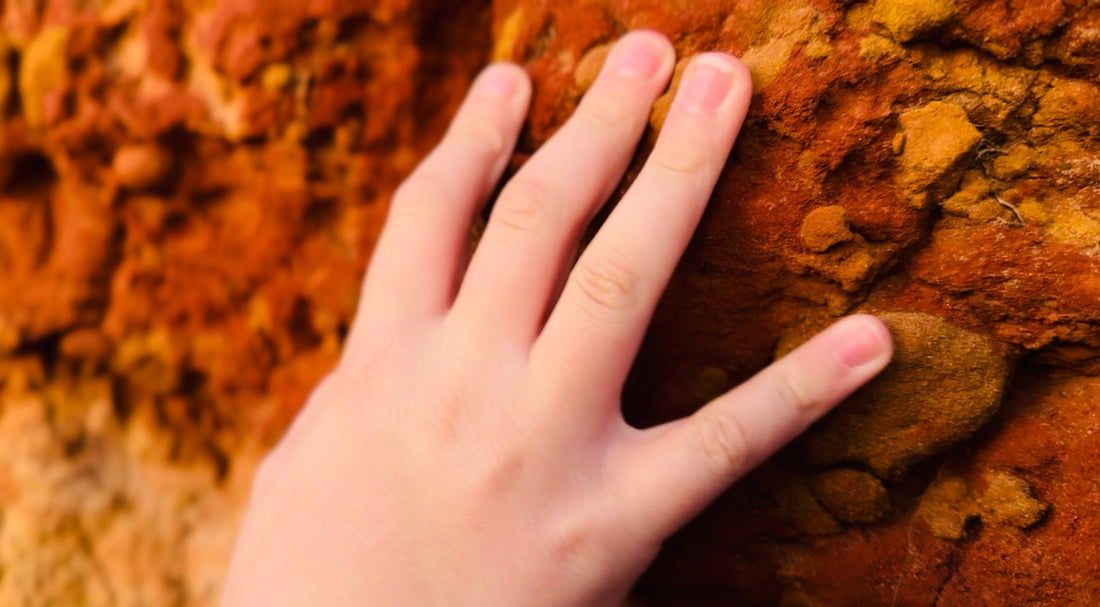
We Touch Plastic More Than We Touch the Earth
30 June 2025Share
It began with a shoreline, rocks, and a feeling. Not a business. Not a product. Just the yearning to bring more of nature's resilience into the home. Years ago, walking along the shoreline with my son, we wandered, beachcombing, collecting shells and wave-worn stones. We loved discovering the patterns, the textures and the earthy tones, a spiral tucked into a shell, a chipped pebble softened by water and time. These small finds spoke of endurance, of how nature holds form, even after being weathered.
Later that afternoon, once home, I pulled out my notebook. Pencil in hand, I felt a wave of inspiration that needed to come through. I began jotting down names of flowers, shapes, textures. That walk stirred something different: a question. What if the spaces we pass through each day could echo nature's quiet resilience?
That question became the beginning of covellite.
Most impactful room
The bathroom is often seen as a place of retreat, a space to reset, to nurture ourselves in a sacred space. But what we often overlook is something vital: the smallest details, which can have the greatest impact. Look closely, and you’ll find it’s one of the most material-heavy rooms in the home. From pump bottles and synthetic wipes to bin liners and fittings much of it is plastic, most of it is short-lived, and very little of it is designed to endure. Australia generated over 2.65 million tonnes of plastic waste in 2020–21, yet only 12.6% was recycled. That includes everything from packaging to product parts, much of it quietly entering landfill, piece by piece, from homes just like ours. Over the years, I was surprised to find how many home accessories became inoperable within months of purchase. A lid that rusted. A dispenser pump that couldn’t be replaced. The kind of quiet waste that slips by unnoticed not because it’s rare, but because we’ve come to expect it. In the UK alone, households throw away more than 1.7 billion pieces of bathroom related plastic packaging every year. And while local figures vary, the trend is global a constant churn of convenience, built into the background of our lives. This is where our story begins. I couldn’t find what I was looking for, something simple, close to nature, well-made. Something that could age well, be repaired, or be traced back to its material origin. That search became a question. And that question became a philosophy. A design philosophy and the foundation of covellite, a quiet response to all the things we’ve stopped questioning.
What we touch most
Modern life is filled with surfaces, things we reach for, lean against, hold without thought. In the quiet rhythm of a morning routine, we come into contact with a dozen objects before we even leave the house. Most of them are plastic. From a toothbrush to a soap pump, a shampoo cap to a razor handle plastic dominates our rituals not because it’s the most enduring material, but because it’s the most convenient. Designed to be touched, then forgotten. We touch plastic more than we touch the earth. And yet what we touch matters. Studies in biophilic design show that materials drawn from nature like timber, stone, clay, and natural fibres, don’t just bring visual warmth. They help reduce stress, improve cognitive function, and enhance overall wellbeing. Nature regulates. Nature grounds. But when our spaces are stripped of that grounding, when plastic becomes our daily texture, something essential is lost. A layer of connection. A quiet memory of place. Covellite’s first collection was born from the desire to change that. Not just to learn from nature, but to restore its presence, not as decoration, but as something we live with. Something we return to, through use. When we design for touch, we also design for memory. And memory, like the earth, asks us to care for what we hold.
The return to nature and what it asks of us
We take nature for granted, just as we trust the sun to rise, seasons to change, and tides to ebb and flow. Its structure, rhythm, and wisdom. It holds patterns that have guided design long before the word design existed. As we explored in our Timeless by Design feature, ancient cultures built in quiet alignment with the land, shaping homes from earth, stone, timber. Their structures were more than shelters, they were stories, rituals, and responses to place. They aged with the seasons. They belonged. But somewhere along the way, we began to build differently. Faster. Flatter. Cheaper. The industrial model prioritised mass over meaning, efficiency over endurance. We've created objects that last forever in all the wrong ways and fall apart in all the wrong places. Even recyclable plastics, long promoted as a solution, rarely get reborn. Global studies show most end up in landfill due to contamination, flawed infrastructure, or poor design.
Our approach is guided by nature, and the materials it provides in abundance. Stone that holds memory. Forms that serve, not just decorate. Parts that can be replaced. Objects that feel of this earth, not detached from it. We don’t just draw inspiration from nature. We design in dialogue with it.
Perhaps the quiet resilience we seek doesn't require extravagant gestures, but simple, intentional choices. Choosing items that last, built to function, repair, or adapt, not merely to fill space. Small decisions add up. What simple shifts can you make to bring nature’s quiet resilience more deeply in the heart of your home?
Further reading
Australian Government, Department of Climate Change, Energy, the Environment and Water. National Plastics Plan Progress Report, 2022.
https://www.dcceew.gov.au/environment/protection/waste/plastics-and-packaging/national-plastics-plan
Plastics in the Bathroom: What's Going to Landfill, 2022.
https://wrap.org.uk/resources/report/plastics-bathroom-whats-going-landfill
Zhong, W., Schröder, T. W. A., & Bekkering, J. D.
Biophilic Design in Architecture and Its Contributions to Health, Well-being, and Sustainability: A Critical Review.
Frontiers of Architectural Research, 2022.
https://doi.org/10.1016/j.foar.2021.07.006
Seay, J. R.
The Global Plastic Waste Challenge and How We Can Address It.
Clean Technologies and Environmental Policy, 2021.
https://link.springer.com/article/10.1007/s10098-021-02271-0

